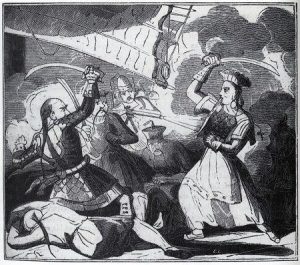Winner of the Fall 2018 StMU History Media Award for
Best Article in the Category of “Crime”
Best Article in the Category of “Political History”
Robert Graysmith, a cartoonist working for the San Francisco Chronicle in 1969, developed an obsession to discover who the Zodiac Killer was. On a rainy night he received an image of a driver’s license of a man named Arthur Leigh Allen. On this license was Allen’s date of birth, December 18, 1933. This information became the final clue in Graysmith’s investigation, allowing him to put all the pieces together to discover the identity of the Zodiac Killer.
On August 1, 1969, the first letter written by the Zodiac Killer was delivered to the San Francisco Chronicle. The letter was a confession to the murder of two teenagers, Darlene Ferrin and Michael Mageau, on July 4, 1969, at Blue Rock Springs Park in Vallejo, California.1 A cypher was attached to the letter and the killer demanded that his cypher and letter be published in the newspaper, threatening to kill more if the paper did not do so. This letter and the cypher that came along with it was the initial spark that led Graysmith into his obsession with finding out who this Zodiac Killer was. He himself tried to decode the cypher by reading different books involving code breaking, but was beaten to solving it by Donald and Bettye Harden, who solved the code themselves. Within the cypher, it talks about “man [being the most] dangerous animal of all.”2 Graysmith discovered that this line was from the movie The Most Dangerous Game, which is about a man who hunts people for sport. Nonetheless, this became Graysmith’s first piece of evidence to be discovered from the Zodiac Killer’s letter; yet, it wasn’t until seven years later, in 1977, when Graysmith started adding up the evidence that would pointhim to Arthur Leigh Allen as the Zodiac Killer.

Arthur Leigh Allen had a friend named Don Cheney, who provided information that pointed to Allen as the prime suspect in the investigation. Cheney had mentioned that on “September 27, 1969 in Napa, California, Allen [had told his family] he’d be leaving for the afternoon to go scuba diving at Lake Berryessa.”3 However, later that day Allen returned home covered in blood with a bloody knife found in his car. That same day a police report was filed for one murder that involved the killing of Cecelia Shepard, age 22, and although Bryan Hartnell was a victim in the attack that killed Shepard, he was able to survive.

Allen’s same friend, Don Cheney, also confessed that Allen referring to himself as the “Zodiac” before the publication of the letters, and even before the murders had taken place. Allen not only referred to himself as “Zodiac,” but also wore a Zodiac brand watch. The police further investigated him by searching his trailer, but “only [found] small dissected animals, bloody knives and sexual devices.” 4 None of this, however, was direct evidence linking Allen to the murders. Although he was not convicted for murder, he was separately convicted of child molestation resulting in a three year sentence in prison. Coincidentally, no Zodiac letters were sent during this time to the San Francisco Chronicle. Additionally, during his time in prison, one of Allen’s inmates reported to the police a confession Allen had told him. Allen reportedly took responsibility for the murder of Paul Stine, a taxi driver who was shot in the head by his passenger. This murder was also mentioned in one of the Zodiac’s letters. Right after this incident, an interview on national television by Melvin Belli had tried to elicit a confession from Allen for the murders, but unsuccessfully. Afterward, the Zodiac Killer tried to reach out to Belli by calling his house on December 18, 1969. Belli was unable to answer, but his maid did. She stated that all the Zodiac Killer said was, “It’s my birthday, I must kill.”5 A chilling, yet important fact in the investigation.

One piece of evidence that seemed to sealed the deal for Graysmith that Allen was the Zodiac Killer was Graymith’s interview with Linda Ferrein. Graysmith sought to question Darlene Ferrin’s sister, Linda Ferrin, to find out whether there was any correlation with her sister and the Zodiac Killer, due to a piece of information referencing Darlene’s painting parties in one of his letters. As Graysmith interviewed Linda, she described Darlene as always being surrounded by boys. But there was one in particular who stood out to her. Linda described this boy as antisocial when he attended one of Darlene’s painting parties. Darlene also warned Linda to stay away from him because she said he scared her, and also mentioned to her sister that this was the same man who confessed to her he had killed someone. Not only that, but he had a nickname for himself, which was Leigh, which was also Allen’s middle name. During that same time, Graysmith received an image of Allen’s driver’s license confirming Allen’s date of birth, December 19, 1933, the same date on which he made a phone call to Melvin Belli stating, “It’s my birthday, I must kill.”6 All of this piled up evidenced convinced Graysmith that Allen was the Zodiac Killer, because this was the only time that the Zodiac Killer gave out a piece of personal information. Unfortunately, authorities planned to have a meeting charging him with all these murders, but Allen suffered from a heart attack before the meeting could take place.

Convincing enough? This is one of the most popular theories from Robert Graysmith who believed the serial murderer was Arthur Leigh Allen. Although there is supporting evidence that points towards him as the killer, many question Graysmith’s judgment and overall investigation. Regardless, the case still remains unsolved and we may never know who the real Zodiac Killer was. Was it Arthur Leigh Allen or was Graysmith’s theory further off than we thought?
- William Booth, “The Zodiac Writer,” The Washington Post, Mar. 09, 2007, http://www.washingtonpost.com/wp-dyn/content/discussion/2007/03/09/DI2007030900522.html (accessed September 5, 2018). ↵
- Robert Graysmith, Zodiac (Penguin Publishing Group, 2007), 78. ↵
- William Booth, “A Killer Obsession,” The Washington Post, Mar. 1, 2007, http://www.washingtonpost.com/wpdyn/content/article/2007/02/28/AR2007022801979.html (accessed September 5, 2018). ↵
- Justin Moyer, “And the Zodiac Killer is…,” The Washington Post, May 14, 2014, https://www.washingtonpost.com/news/morning-mix/wp/2014/05/14/and-the-zodiac-killer-is/?utm_term=.28c06c343598 (accessed September 7, 2018). ↵
- Robert Graysmith, Zodiac unmasked (New York: Berkley Books, 2003), 180. ↵
- Robert Graysmith, Zodiac unmasked (New York: Berkley Books, 2003), 180. ↵



125 comments
Daniel Reyes
This article did a job of depicting the allure that surrounds the Zodiac Killer, which is creepy and cult-like. I understand from the article and the movie Zodiac (2007) a 2000’s classic film starring Jake Gyllenhaal and Robert Downey Jr. depicting the story behind the killer and the chase for the truth. I think this article mimics the movies storytelling ability, which continues to be fantastic in describing the hunt and mystery of true crime mystery stories. I think what this article does best is telling a story to readers in a way that is enjoyable to read. What I think this article could do better on is also including the Robert Graysmith’s relationship and how his continued search almost cost him his marriage.
Engelbert Madrid
This article gave me chills after I read the last paragraph. Each detail and information given in this article set a mood of shock on how a man could have had the pleasure to kill people for enjoyment. Furthermore, each image depicts the mystery of this criminal who remains to be unknown. It might have been Arthur Leigh Allen, but investigators are not 100% sure this man was responsible for the deaths of many people.
Stephanie Nava
I have heard of the Zodiac Killer, but I never knew that he was never caught! It is creepy to think that if it was not Arthur Leigh Allen, the Zodiac Killer could possibly still be out there. But after reading this article and all the evidence that was found against him, I feel like it was Arthur. I like how the author included one of the letters he sent in the article. It is astonishing to see what people are capable of!
Natalie Thamm
This was a really interesting article. While I had known some about the Zodiac Killer, I had not known really any of the background around the theory that Arthur Leigh Allen was in fact this infamous killer. The author did a good job of describing Graysmith’s method of determining that Allen was the killer, but I do think that it may have been rushed or him wanting to put together facts that not necessarily all fit together.
Dylan Sanchez
Such a creepy image depicting this killer. I had no idea he did such things for pleasure. It’s crazy to see what the human mind is capable of and that this was once a child. How can someone become so demented? To wish to kill on someone’s birthday? Although it pains me to say this, I’m quite impressed with him. How could someone have a primal rage yet devise these killings so well and not be caught. Great article.
Robert Rees
The one aspect of the Zodiac Killer mystery I think this article captures really well is the doubt that arises whenever a theory regarding the killer is made known. Some people after reading this article might be convinced that the Zodiac Killer was indeed Arthur Leigh Allen, and that Robert Graysmith solved the mystery that the police couldn’t. Whereas others might read this article and say that all the evidence Robert Graysmith gathered was nothing more than a series of coincidences. Overall I think this article is very well written and takes an interesting approach in examining America’s most infamous serial killer.
Noah Bolhuis
Reading about psychopathic serial killers is always a weird thing to do. Sometimes you feel like if they didn’t do one thing or another they could have gotten away with their crimes and kept committing the crime more. It is interesting that he allowed one of his victims to survive, whether on purpose or accident. That is the one thing that a murderer has to make sure happens: his victim is dead. Especially if they have done this crime many times before. However, getting this sick killer off the streets was a weight off a lot of people’s shoulders.
Enrique Segovia
This was a great article! I enjoyed reading about the Zodiac Killer. I find it really interesting how Robert Graysmith was able to deduce and speculate that Allen was this infamous killer. Also, it is horrible how this man committed these atrocities out of pleasure, like sending that message when it was his birthday, demonstrating his urge to kill. The cover picture plays along well with the article, and it is scary to think that a crazy man dressed like that was a serial killer who was never found.
Annissa Noblejas
The Zodiac Killer is one of the greatest unsolved serial killer cases in the country. There is a lot of circumstantial evidence that points towards Arthur Allen as the man behind these crimes, but nothing solid ever came from the investigations. Unfortunately, DNA sequencing as physical evidence was not available at this time, otherwise the bloody objects found in his possession could have been used to aid in determining his guilt or innocence.
Gabriela Ochoa
This was a great article, I liked that you took the path of following a cartoonist who had an interest in him instead of just following his own story. I felt that the article gave great details on what happened and the process taken by the cartoonist himself to find out if Allen was truly the killer. It sad to see that they never truly knew if he was the killer or not and that those he killed and affected by his doings will never get justice.